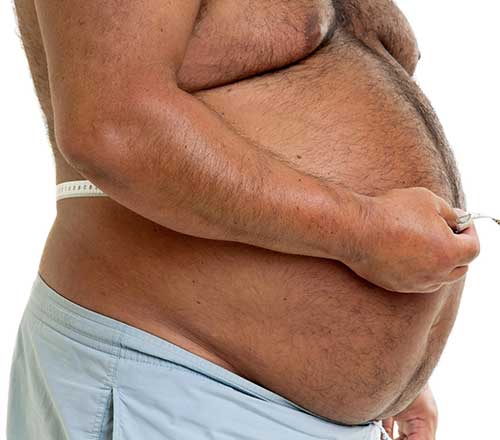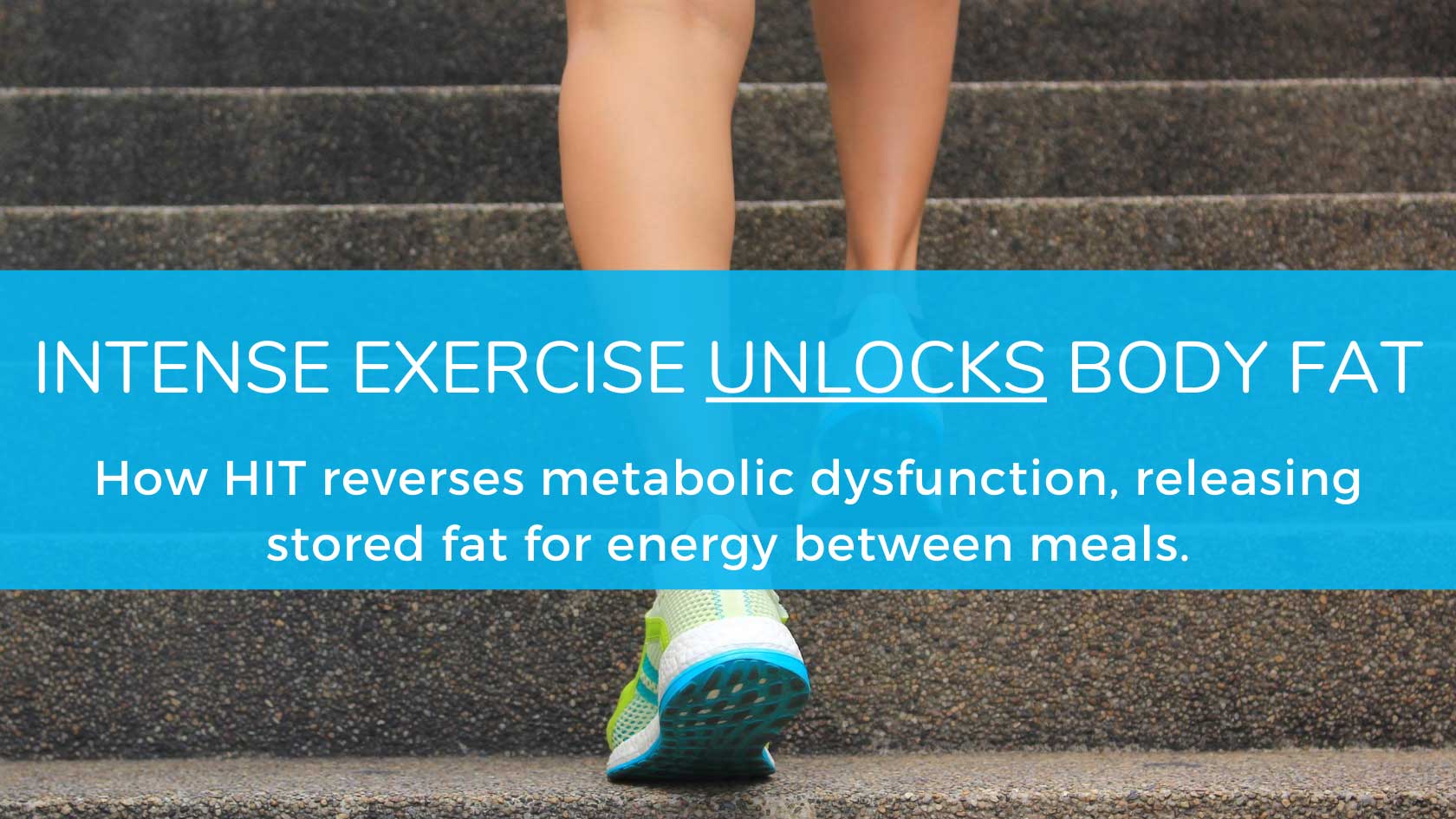This is part III of a series on exercising for fat loss and improved metabolic health.
If we want to lose weight and keep it off sustainably, we have to prioritize appetite control. We already saw how over-exercising can derail that effort by causing us to overeat, and learned how shifting our focus to short, high effort training can help us control our cravings.
Now, we’re going to learn how exercising with very high effort can go one step further, by actually making it easier for our bodies to let go of stubborn body fat in between workouts. To do this, we have to understand how our body fat, and our metabolisms, become dysfunctional in the first place, and how glycogen-depleting intense exercise can help.
Water, water, everywhere but not a drop to drink … Metabolic dysfunction.
When it comes to body fat, we have to ask “Why am I hungry if I have all this extra stored energy?” The answer, in part, is a master metabolic hormone called insulin, which regulates how our bodies manage energy. Like cortisol and other hormones, insulin is meant to show up intermittently to do an important job. But when it stays chronically elevated, it can wreak havoc on our health. Here’s how.

Why aren’t we burning fat, instead of getting hungry between meals?
In between meals (“fasted”), we shouldn’t have much hunger, because we should be burning the fuel that’s already in our full gas tank (body fat). But when our metabolisms aren’t working right (a.k.a. “metabolic syndrome”), hormones like insulin prevent this stored fat from being used, and we feel hungry all the time. We wake up in the middle of the night craving food. We need to snack between meals. We just can’t seem to use all this stored body fat for energy. It’s almost like we can only use the gas in our fuel lines, while the gas tank is locked shut. Why? Chronically elevated insulin plays a key role, and the easiest way to drive insulin levels up is by eating more glucose than our bodies can use, which is the energy in dietary carbohydrates such as potatoes, pasta, rice, and crackers.
Unlike dietary fat, carbohydrates have to be dealt with immediately.
Even though our bodies mainly prefer to store energy as fat, our red blood cells and neurons can’t use fats for energy. These cells rely on glucose, making it a crucial fuel for healthy functioning. Our bodies also store glucose as an emergency fuel in our muscles, called glycogen (mentioned in part II of this series), which can be burned quickly during periods of maximal exertion.

A small but steady supply of glucose is so important that our livers can easily manufacture all the glucose we need to live. This makes carbohydrates valuable, but also non-essential, in that we don’t absolutely need to eat them to get by.
Glucose is a doubled-edged sword.
High blood sugars, or blood glucose levels, are very damaging. As a highly reactive molecule, glucose can damage proteins when it is too highly concentrated in the blood. If you’ve ever heard of the blood marker “HbA1c,” which is familiar to diabetics, it measures how much damage has been done by blood sugar (glucose) to the oxygen carrying protein hemoglobin. A high HbA1c is an indicator of how high our blood sugars have been, showing how much damage excess glucose has done to our blood cells and vessels. High blood sugars are no bueno.
Amazingly, “normal” blood sugars of less than 80-90 milligrams per deciliter amount to just 1 teaspoon of glucose in the entire blood supply. This is the amount needed to keep our brains happy, Without precise controls, it doesn’t take much to throw this precise machine out of calibration! So when blood sugars go up after a meal, our body takes immediate action to get any excess glucose out of the blood and into the muscle and liver, where it can be stored as an emergency fuel source. To achieve this, our pancreas releases insulin, which has two primary actions.

Insulin tells muscles to absorb glucose quickly, even if they don’t need it.
When insulin binds to a muscle cell, that cell opens its doors to let glucose in. So when the body needs to get glucose levels back down to normal, releasing insulin from the pancreas is the fastest way to do that. Muscles can absorb glucose without insulin when their glycogen levels get low. In a perfect world, our muscles would always be empty and ready to absorb any glucose that enters the blood, and our pancreases would need to release only a little insulin to ensure this happened smoothly.
Insulin also tells body fat to stop releasing energy until blood sugars are normal.
Another way that insulin controls blood sugars is that it prevents fat cells from releasing fat for fuel. This is so that the body switches to primarily storing or consuming the glucose first. Again, this valuable glucose is also dangerous at high levels, and so our bodies want to get any excess glucose out of the blood stream immediately. By telling body fat to hold onto it’s fatty acids, the body forces the tissues to absorb the glucose instead, getting it out of circulation quickly. So where does it all go wrong?
We have a very limited ability to store extra glucose from carbohydrates.
As I mentioned, energy stored in the muscle is called glycogen. This large chain of glucose molecules serves as emergency fuel when we need to fight off an attacker, sprint from a predator, or chase down our next meal. It is burned during high intensity, unsustainable efforts. And because it is for emergencies only, we store only a few hundred grams in our whole body. Even a very thin person has FAR more fat on their body than stored glycogen. Until we perform deeply exhausting, max-effort exertion, these stores remain full.
Our bodies will accept long term risks to solve short term problems.
Even when a muscle is already full of stored glucose (glycogen), the pancreas can “shout” at the muscles to take in and burn what they may not need by releasing extra insulin into the blood. In the long term, forcing cells to burn what they don’t need can create oxidative stress and mitochondrial damage. But in the short term, the body is happy because blood sugar levels get forced back into a healthy range.
If muscles are full of glycogen, more insulin is needed to control blood sugars.
So let me ask you … when was the last time you had to run away from a lion?
This is the problem. Despite the fact that many of us stay active, we very rarely have to run or push as fast and hard as we possibly can. We can hike all day and make only a small dent in our glycogen stores, which the body cleverly holds in reserves for true emergencies. In fact, even running a submaximal can run an entire marathon won’t fully deplete our muscle glycogen stores!
Muscles won’t readily absorb glucose they don’t need, which drives up insulin levels.
In our modern environment, where maximal exertion is rare, and dietary carbohydrates are almost limitless, our muscles become and remain almost permanently full of glycogen, or “glycogen replete.” We rarely have a need to burn our emergency fuel reserves, but we eat enough to replenish them at almost every meal. Ever increasing insulin levels then become necessary to try to keep blood glucose in check.
This excess insulin will have several effects that worsen hunger and compromise health.
First, insulin slows the release of fatty acids until the blood sugar levels normalize. In essence, we become less able to use the fat on our bodies, despite the abundant energy it contains.
Second, excess insulin will hurt our liver’s ability to regulate energy levels between meals. While the pancreas keeps blood sugars from getting too high, the liver is the master at keeping blood sugars from dropping too low. It can release stored glucose, and even synthesize it. But when insulin is chronically elevated, both of these are hindered.

Finally, and paradoxically, excess insulin can make it harder to store fatty acids, in part because the target fat cells are already full to capacity. The result is fats getting stored in and around our organs in our abdomen. This is what produces the “apple-shaped” body type that is more associated with metabolic syndrome when compared to a “pear-shaped” body type. Visceral fat is a bad sign of metabolic dysfunction.
Excess insulin hangs around, continuing to cause problems even when its work is done.
The problem is that all the extra insulin doesn’t just evaporate when blood sugars normalize. It sticks around, locking away body fat, while slowly driving blood sugars too low and preventing the liver from getting these levels back up. This is called “reactive hypoglycemia” and it results in severe hunger several hours after a meal. If a person has plenty of stored energy as fat, but is always hungry, insulin is almost certainly elevated chronically.
So should we all eat low-carb diets? Do they have a place?
What I’m not saying is that dietary carbs are evil. A healthy, whole foods diet that incorporates fresh fruit and root veggies like potatoes and carrots can be very sustainable and health promoting. But many processed foods that are easy to overeat, like french fries, soda, chips, crackers, desserts, and pizza, happen to be almost pure carbohydrate. This is a big part of the problem. These foods lend themselves to overconsumption, driving insulin levels ever higher.
So what is the answer? Well, dietary interventions to address this problem deserve their own post, if not textbook. However, you’d be sensible to ask the question “should I eat fewer carbohydrates?” Most of the junk food we eat is heavily processed and full of refined carbohydrate. And if glycogen stores are always full, it does make sense to look into the supply side of the equation and consider filling these stores up less frequently, based on how often we actual use this emergency fuel. However, any diet that reduces energy coming in sustainably, by controlling hunger while avoiding nutrient deficiency, is going to be very beneficial.

Can we use exercise to address the glycogen-insulin problem?.
This post is not mainly about diet, but about how exercise can be a tool to reverse metabolic disease. If the goal is to get insulin levels lower, so that body fat becomes more accessible, than we need to exercise in a way that empties muscles of their stored glycogen. By focusing on burning glycogen, and not total calories, we can reduce the amount of insulin needed at our next meal to normalize blood sugars.
High Intensity Training jumpstarts a sensible diet, and makes it more sustainable.
A diet that requires perfect compliance for a lifetime is likely to fail. We need to find a way to use exercise to improve our hormonal tolerance to the occasional dietary indulgence, without getting stuck in the appetite-driving cycle of “I overate this weekend, so I need to go live on the treadmill.” When people fast completely from food, it can take 24-48 hours to see major reductions in muscle glycogen. However, brief but very high intensity sprint training can completely deplete glycogen in just two maximal effort sprints. In this way, intense but brief sprint-type training basically fast-forwards us towards the insulin levels we might normally see in a fasted state, making dietary strategies more sustainable. By burning glycogen more frequently with High Intensity Training, we can prevent these glycogen stores from becoming over-full when we enjoy the occasional carbohydrate rich food. High Intensity Training using the CAR.O.L. AI bike depletes glycogen, lowering insulin levels. (carolfitai.com)
Exercise is a tool to burn glycogen, not a way to get rid of extra calories.
At StrengthSpace, we understand that we should focus on the stimulus, or message we send our bodies with each rep, and not to do reps for their own sake. We realize that, when it comes to building stronger tissues, it is the fatigue experienced by the muscle that matters, not whether we set a personal record.
In the same way, when it comes to weight loss, what matters is NOT calories burned, but the effect the exercise has on our hormones. In addition to building thicker and stronger bones, tendons, and muscles, we can also improve our sensitivity to insulin by specifically burning glycogen in skeletal muscle through maximal exertion.
When glycogen stores are empty, insulin levels fall, unlocking body fat for use.
When we deeply empty our body’s supply of “emergency fuel” or glycogen, the muscles take it on themselves to start absorbing any extra glucose out of the bloodstream to replace it. Now, the next time we eat carbohydrates, less insulin is needed to return blood sugars to normal levels.
Over time, with less insulin constantly in circulation, body fat becomes available for energy in between meals. Hunger levels are better controlled, and it becomes easier to stick to a healthy diet. Essentially, burning glycogen with intelligent, high effort exercise gets us many of the benefits of low-carb or ketogenic diets, and even enhances the effects of these diets, by helping us get insulin signaling as low as possible.
So, how do we actually empty glycogen stores in our muscles without creating an overpowering hunger?
High Intensity Training can deplete glycogen in less than 10 minutes. Here’s how.
video credit to www.carolfitai.com
The answer is very brief, high effort exercise. As we learned in the last article, high intensity training burns far more glycogen than long duration exercise. This is incredibly liberating, because it means we don’t need to live in the gym to reverse metabolic disease!
Anyone can devote 10 minutes, three times per week, to improving their metabolic health. While a highly active lifestyle is ideal, don’t be intimidated into thinking that it takes hours and hours to make a change to your health. The research is clear: just a few high-intensity type workouts can make an enormous difference to your blood sugars and your metabolic health. If you want to learn how you can get these results in the smallest time commitment possible, read more about our artificial intelligence CAR.O.L. bike here. Thanks for reading, and subscribe below to be notified about our next article!


